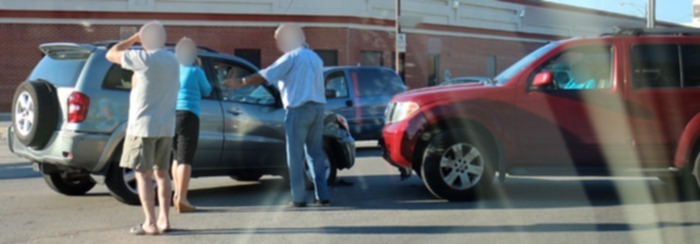Luật Mỹ dài dòng, nhưng cách thi road test này giúp các bạn nắm được cách lái xe ở Mỹ (dành cho người chưa từng đi):
Road Test
You will drive over a test route that may have a variety of traffic situations. You will follow the directions of the examiner. Directions will be given to you so you will have plenty of time to do what the examiner has asked. You will not be asked to drive in an unsafe manner. At all times during the test, you must drive safe and responsibly. During the driving test, the examiner will be scoring you on specific driving maneuvers as well as on your general driving behavior.
With a parent/guardian or friend, who is properly licensed and over the age of 21, practice driving in low traveled, residential areas until you are confident you can drive in other types of traffic situations, such as urban areas and expressways. All new drivers are encouraged to take a driver’s education course as driving is a complicated task.
How You Will Be Tested
Turns
You have been asked to make a turn. As you approach the turn:
o
Check traffic in all directions, use the correct turn signal, brake smoothly and evenly and safely get into the correct lane needed for the turn.
If you must stop before making the turn because of traffic, signals or signs:
o
Smoothly come to a complete stop without skidding behind the stop line, crosswalk, or stop sign. A safe gap when stopping behind another vehicle is to stop where you can see the rear tires of the vehicle ahead of you. Keep the front wheels aimed straight ahead.
When ready to turn:
o
Check traffic in all directions. Keep both hands on the steering wheel during the turn. Maintain smooth even acceleration and yield to pedestrians and other traffic. Keep checking your mirror to make sure the vehicle does not hit anything on the inside of the turn. Do not move into oncoming traffic or drive over the curb. Keep the vehicle in the proper lane.
After turn:
o
Make sure you finish completing the turn in the correct lane and that your turn signal has cancelled. Accelerate to the speed of traffic, use your turn signal, check your blind spots by looking over your shoulder (head check), check your mirrors and move into the right-most lane when it is safe to do so (if not already there).
Intersections
As you approach an intersection:
o
Check traffic thoroughly in all directions. Brake smoothly and evenly and maintain lane position.
When stopping at an intersection:
o
If necessary, come to a complete stop behind any stop signs, signals, sidewalks, or stop lines. If stopping behind another vehicle maintain a safe gap. You should be able to see the rear tires of the vehicle ahead of you.
When driving through an intersection:
o
Check traffic thoroughly in all directions. Keep both hands on the wheel and slow down and yield to any pedestrians or traffic in the intersection. Do not change lanes while proceeding through the intersection.
Once through the intersection:
o
Continue checking mirrors and traffic behind you. Accelerate smoothly. If there are multiple lanes of traffic, accelerate to the speed of traffic, use your turn signal, check your blind spots by looking over you shoulder (head check), check your mirrors and move into the right-most lane when it is safe to do so (if not already there).
93
Urban
During this part of the test, you are expected to make regular traffic checks, check cross traffic and maintain a safe following distance. Your vehicle should be centered in the proper lane (right-most lane) and you should keep up with the flow of traffic, but not exceed the posted speed limit.
Rural/Open Highway
During this part of the test, you are expected to make regular traffic checks, check cross traffic and maintain a safe following distance. Your vehicle should be centered in the proper lane (right-most lane) and you should keep up with the flow of traffic, but not exceed the posted speed limit.
Lane Changes
During multiple lane portions of the test, you will be asked to change lanes to the left, and then back to the right. You should make the necessary traffic checks first by looking in your mirrors and checking your blind spots by looking over your shoulder (head check). Make sure you use the correct turn signal and smoothly change lanes when it is safe to do so. Cancel your turn signal upon completion and check traffic.
Expressway
When entering the expressway:
o
Check traffic by looking in your mirrors and checking your blind spots by looking over your shoulder (head check). Make sure you use your turn signal. While increasing speed, smoothly merge into the proper lane of traffic without stopping or crossing over any solid painted lines. Cancel your turn signal upon completion of the merge.
Once on the expressway:
o
Maintain proper lane positioning, vehicle spacing and vehicle speed. Continue to check traffic thoroughly in all directions.
When exiting the expressway:
o
Make necessary traffic checks. Use proper signals and brake smoothly once you enter the deceleration lane. Continue to decelerate within the lane markings, follow posted warning speeds and maintain adequate spacing between your vehicle and other vehicles. Cancel your turn signal upon completion of exiting the expressway.
Limited Access Roadway
When entering the limited access roadway:
o
Check traffic by looking in your mirrors and checking your blind spots by looking over your shoulder (head check). Make sure you use your turn signal. While increasing speed, merge or turn smoothly into the proper lane of traffic without stopping (unless necessary) or crossing over any solid painted lines. Cancel your signal upon completion of the merge or turn.
Once on the limited access roadway:
o
Maintain proper lane positioning, vehicle spacing and vehicle speed. Continue to check traffic thoroughly in all directions.
When leaving the limited access roadway:
o
Make necessary traffic checks. Use proper signals and brake smoothly once you enter the deceleration or turning lane. Continue to decelerate within the lane markings, follow posted warning speeds and maintain adequate spacing between your vehicle and other vehicles. Cancel your signal upon completion of exiting the limited access roadway.
94
Curve
When approaching a curve:
o
Check traffic thoroughly in all directions. Before entering the curve, reduce your speed so further braking is not required in the curve. Keep vehicle in the lane. Continue checking traffic in all directions. Maintain a safe speed through the curve and follow posted warning signs.
Traffic Signs
During the road test you will be asked to identify a number of traffic signs. They can be located anywhere on the road test. If the examiner asks you what road sign you just passed you should be able to tell the examiner.
General Driving
Use brakes properly:
o
Do not brake harshly. Brake smoothly using steady pressure. Come to a complete stop at traffic signs or signals.
Proper steering:
o
Keep both hands on the outside of the steering wheel at all times unless using other controls. Once you have completed using other controls return both hands to the steering wheel. All methods of steering are acceptable (i.e., hand-over-hand and hand-to-hand) as long as both hands are on the outside of the wheel.
Proper lane usage:
o
Do not put vehicle over curbs, sidewalks or lane markings. Complete a turn in the proper lane on a multiple lane road (vehicle should finish a left turn in the left-most lane, the one directly to the right of the centerline). Finish a right turn in the right-most (curb) lane. Move to or remain in the right-most lane unless lane is blocked. Do not attempt lane changes at intersections.
Regular traffic checks/head checks:
o
Check traffic and mirrors regularly. Check traffic and mirrors before, while in and after an intersection, turn or lane change. Watch for hazards by searching left and right at intersections, driveways, store entrances, railroad tracks or any other areas where traffic intersects. Scan and check traffic in high volume areas and areas where pedestrians are expected to be present. Check traffic by looking over your shoulder (head check) when necessary (i.e. lane change, merging).
Use of turn signals:
o
Use turn signals when required. Activate turn signals at appropriate times. Do not signal too early or too late. Cancel turn signals upon completion of a turn or lane change.
Stopping at stop line or crosswalk or gap:
o
When stopping at a stop sign or traffic signal do not stop over marked stop line, pedestrian crosswalk, sidewalk or other marker. Do not stop vehicle in the intersection. When stopping behind another vehicle make sure you can see the rear wheels of the vehicle in front of you.
Automatic Failures
If any of the following errors occur during the road test the examiner will automatically fail you for the remainder of the test:
If you do not use your safety belt.
95
If you receive a traffic citation for a moving violation, disobey signs or signals, speed, roll through stops, or ignore traffic laws.
If you do not yield to pedestrians or other roadway users.
If you are involved in an avoidable crash or if your vehicle has physical contact with other vehicles, objects or pedestrians.
If you commit any unsafe act or if another driver is forced to take evasive actions in order to prevent a crash.
If you put the vehicle over sidewalks or curbs unnecessarily.
If the examiner has to take control of the vehicle.
Basic Control Skills on Road Test
During the Road Test you will be asked to demonstrate some of the basic control skills exercises (e.g. two-point turnabout, three-point turnabout, parallel parking) in a real world setting. The examiner will provide you with instructions. Upon completion of the exercise you will continue on with the Road test.
Conclusion
At the end of the tests, the examiner will discuss the results of each test and provide recommendations for possible improvement.

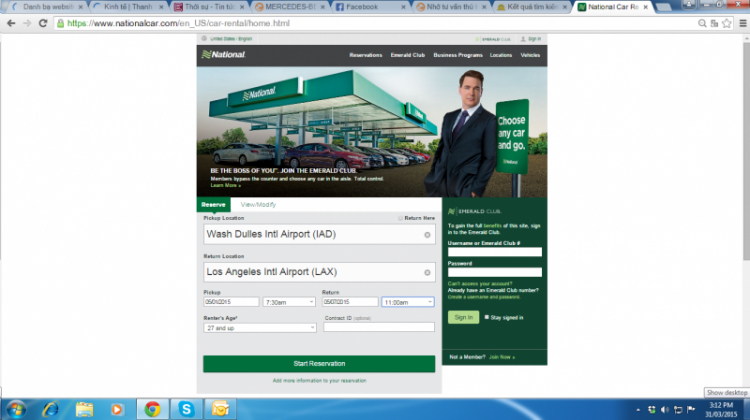
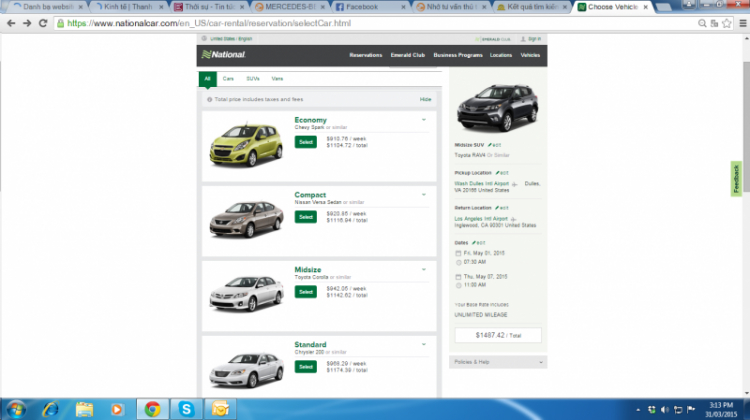
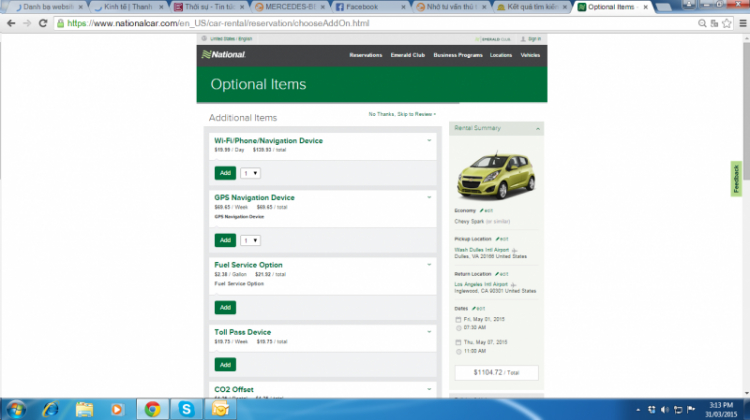
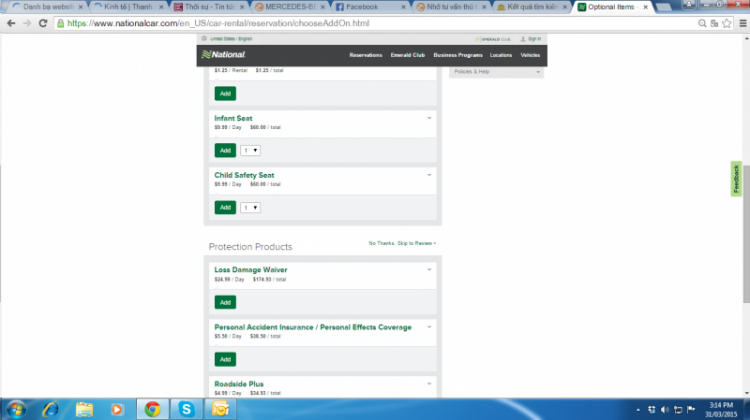



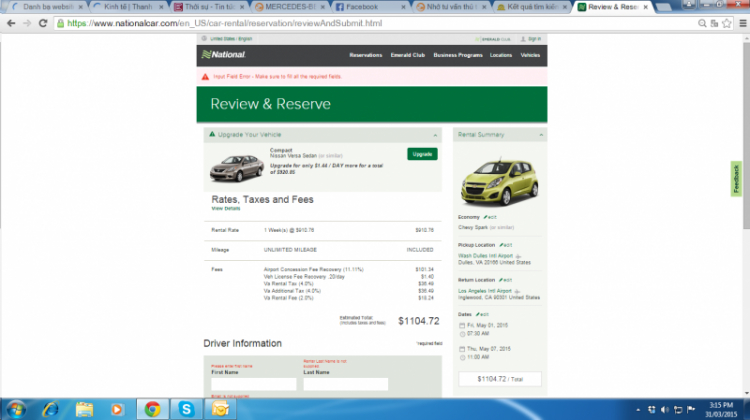





















 . Em đi từ sân bay Norfolk đến NY ( chưa kể lòng vòng chơi hết cũng cả 200 miles) thì ngoài Full bình + thêm có 10 USD xăng hà. Về trả xe vẫn còn hơn 1 /4 bình.
. Em đi từ sân bay Norfolk đến NY ( chưa kể lòng vòng chơi hết cũng cả 200 miles) thì ngoài Full bình + thêm có 10 USD xăng hà. Về trả xe vẫn còn hơn 1 /4 bình. . Phương án xài 3G cũng okie.
. Phương án xài 3G cũng okie.